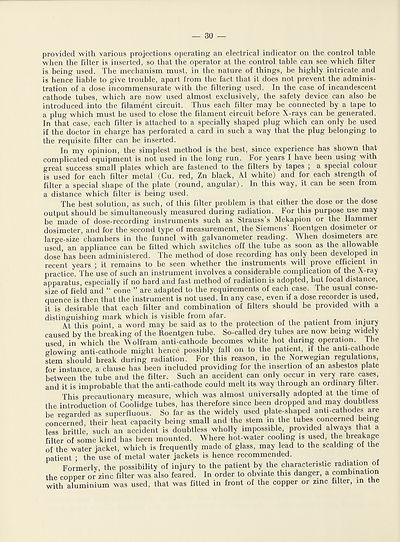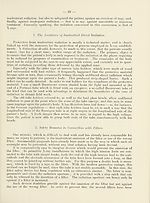Health > Protective measures against dangers resulting from the use of radium, roentgen and ultra-violet rays
(32)
Download files
Complete book:
Individual page:
Thumbnail gallery: Grid view | List view

— 30 —
provided with various projections operating an electrical indicator on the control table
when the filter is inserted, so that the operator at the control table can see which filter
is being used. The mechanism must, in the nature of things, be highly intricate and
is hence liable to give trouble, apart from the fact that it does not prevent the adminis¬
tration of a dose incommensurate with the filtering used. In the case of incandescent
cathode tubes, which are now used almost exclusively, the safety device can also be
introduced into the filament circuit. Thus each filter may be connected by a tape to
a plug which must be used to close the filament circuit before X-rays can be generated.
In that case, each filter is attached to a specially shaped plug which can only be used
if the doctor in charge has perforated a card in such a way that the plug belonging to
the requisite filter can be inserted.
In my opinion, the simplest method is the best, since experience has shown that
complicated equipment is not used in the long run. For years I have been using with
great success small plates which are fastened to the filters by tapes ; a special colour
is used for each filter metal (Cu. red, Zn black, A1 white) and for each strength of
filter a special shape of the plate (round, angular). In this way, it can be seen from
a distance which filter is being used.
The best solution, as such, of this filter problem is that either the dose or the dose
output should be simultaneously measured during radiation. For this purpose use may
be made of dose-recording instruments such as Strauss’s Mekapion or the Hammer
dosimeter, and for the second type of measurement, the Siemens’ Roentgen dosimeter or
large-size chambers in the funnel with galvanometer reading. When dosimeters are
used, an appliance can be fitted which switches off the tube as soon as the allowable
dose has been administered. The method of dose recording has only been developed in
recent years ; it remains to be seen whether the instruments will prove efficient in
practice. The use of such an instrument involves a considerable complication of the X-ray
apparatus, especially if no hard and fast method of radiation is adopted, but focal distance,
size of field and “ cone ” are adapted to the requirements of each case. The usual conse¬
quence is then that the instrument is not used. In any case, even if a dose recorder is used,
it is desirable that each filter and combination of filters should be provided with a
distinguishing mark which is visible from afar. . . .
At this point, a word may be said as to the protection of the patient from injury
caused by the breaking of the Roentgen tube. So-called dry tubes are now being widely
used in which the Wolfram anti-cathode becomes white hot during operation. Ihe
glowing anti-cathode might hence possibly fall on to the patient, if the anti-cathode
stem should break during radiation. For this reason, in the Norwegian regulations,
for instance a clause has been included providing for the insertion of an asbestos plate
between the tube and the filter. Such an accident can only occur in very rare cases,
and it is improbable that the anti-cathode could melt its way through an ordinary filter.
This precautionary measure, which was almost universally adopted at the time of
the introduction of Coolidge tubes, has therefore since been dropped and may doubtless
be regarded as superfluous. So far as the widely used plate-shaped anti-cathodes are
concerned, their heat capacity being small and the stem in the tubes concerned being
less brittle such an accident is doubtless wholly impossible, provided always that a
filter of some kind has been mounted. Where hot-water cooling is used, the brea age
of the water jacket, which is frequently made of glass, may lead to the scalding of the
patient ; the use of metal water jackets is hence recommended.
Formerly, the possibility of injury to the patient by the characteristic radiation o
the copper or zinc filter was also feared. In order to obviate this danger, a combination
with aluminium was used, that was fitted in front of the copper or zinc filter, in the
provided with various projections operating an electrical indicator on the control table
when the filter is inserted, so that the operator at the control table can see which filter
is being used. The mechanism must, in the nature of things, be highly intricate and
is hence liable to give trouble, apart from the fact that it does not prevent the adminis¬
tration of a dose incommensurate with the filtering used. In the case of incandescent
cathode tubes, which are now used almost exclusively, the safety device can also be
introduced into the filament circuit. Thus each filter may be connected by a tape to
a plug which must be used to close the filament circuit before X-rays can be generated.
In that case, each filter is attached to a specially shaped plug which can only be used
if the doctor in charge has perforated a card in such a way that the plug belonging to
the requisite filter can be inserted.
In my opinion, the simplest method is the best, since experience has shown that
complicated equipment is not used in the long run. For years I have been using with
great success small plates which are fastened to the filters by tapes ; a special colour
is used for each filter metal (Cu. red, Zn black, A1 white) and for each strength of
filter a special shape of the plate (round, angular). In this way, it can be seen from
a distance which filter is being used.
The best solution, as such, of this filter problem is that either the dose or the dose
output should be simultaneously measured during radiation. For this purpose use may
be made of dose-recording instruments such as Strauss’s Mekapion or the Hammer
dosimeter, and for the second type of measurement, the Siemens’ Roentgen dosimeter or
large-size chambers in the funnel with galvanometer reading. When dosimeters are
used, an appliance can be fitted which switches off the tube as soon as the allowable
dose has been administered. The method of dose recording has only been developed in
recent years ; it remains to be seen whether the instruments will prove efficient in
practice. The use of such an instrument involves a considerable complication of the X-ray
apparatus, especially if no hard and fast method of radiation is adopted, but focal distance,
size of field and “ cone ” are adapted to the requirements of each case. The usual conse¬
quence is then that the instrument is not used. In any case, even if a dose recorder is used,
it is desirable that each filter and combination of filters should be provided with a
distinguishing mark which is visible from afar. . . .
At this point, a word may be said as to the protection of the patient from injury
caused by the breaking of the Roentgen tube. So-called dry tubes are now being widely
used in which the Wolfram anti-cathode becomes white hot during operation. Ihe
glowing anti-cathode might hence possibly fall on to the patient, if the anti-cathode
stem should break during radiation. For this reason, in the Norwegian regulations,
for instance a clause has been included providing for the insertion of an asbestos plate
between the tube and the filter. Such an accident can only occur in very rare cases,
and it is improbable that the anti-cathode could melt its way through an ordinary filter.
This precautionary measure, which was almost universally adopted at the time of
the introduction of Coolidge tubes, has therefore since been dropped and may doubtless
be regarded as superfluous. So far as the widely used plate-shaped anti-cathodes are
concerned, their heat capacity being small and the stem in the tubes concerned being
less brittle such an accident is doubtless wholly impossible, provided always that a
filter of some kind has been mounted. Where hot-water cooling is used, the brea age
of the water jacket, which is frequently made of glass, may lead to the scalding of the
patient ; the use of metal water jackets is hence recommended.
Formerly, the possibility of injury to the patient by the characteristic radiation o
the copper or zinc filter was also feared. In order to obviate this danger, a combination
with aluminium was used, that was fitted in front of the copper or zinc filter, in the
Set display mode to:
![]() Universal Viewer |
Universal Viewer | ![]() Mirador |
Large image | Transcription
Mirador |
Large image | Transcription
Images and transcriptions on this page, including medium image downloads, may be used under the Creative Commons Attribution 4.0 International Licence unless otherwise stated. ![]()
| League of Nations > Health > Protective measures against dangers resulting from the use of radium, roentgen and ultra-violet rays > (32) |
|---|
| Permanent URL | https://digital.nls.uk/191800602 |
|---|
| Shelfmark | LN.III |
|---|---|
| Description | Over 1,200 documents from the non-political organs of the League of Nations that dealt with health, disarmament, economic and financial matters for the duration of the League (1919-1945). Also online are statistical bulletins, essential facts, and an overview of the League by the first Secretary General, Sir Eric Drummond. These items are part of the Official Publications collection at the National Library of Scotland. |
|---|---|
| Additional NLS resources: |
|

